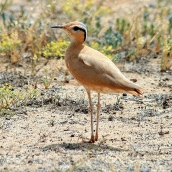Cream-coloured Courser (Cursorius cursor)
A ground-nesting steppe bird, up to 24-27 cm long, wingspan 51-57 cm. Its colouring helps it blend in with the sandy tones of its environment. Wings are partly black and the head is topped by a bluish-grey crown, a black and white stripe extending behind each eye. This species has three toes, which is characteristic of other terrestrial birds adapted to arid and semi-arid environments. It prefers running to flying, hence the name of courser. In Macaronesia it is only found in the Canaries (Fuerteventura, Lanzarote and La Graciosa, Tenerife—where it has recently bred—and Gran Canaria, where it no longer breeds) and Cape Verde (São Vicente, Sal, Boavista, Maio and Santiago, with sporadic sightings in Santo Antão, Santa Luzia, Raso and São Nicolau). The species inhabits arid plains of sandy or stony terrain, but rarely malpaíses or badlands. It mainly feeds on terrestrial invertebrates, especially insects, and the occasional small reptile. Breeding takes place at different times according to the group of islands in question. Clutches (2 eggs) are produced in the Canaries between January and June, while in Cape Verde the breeding season extends from September to May. This bird is well-adapted to arid and desert-like environments and is able to breed in times of drought, though breeding usually coincides with local rainfall. Two subspecies have been described in Macaronesia: C. bannermani (Canaries) and C. exsul (Cape Verde), although they may not be valid. It is only common in the flattest and most arid islands (Fuerteventura, Sal, Boavista, Maio and Santiago), but the arrival of individuals from colonies in Northwest Africa, where the species is abundant, cannot be ruled out. Recent figures for the Canary Islands estimate an average of around 2,000 individuals, but there are no data for Cape Verde. Main threats include habitat alteration and loss, human encroachment, collision with overhead cables, roadkill and poaching. This species is very sensitive to the fragmentation of the plains it inhabits and is considered under threat in the Canaries.













